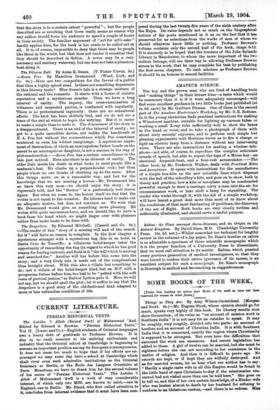AMATEUR SCIENCE.
The boy and the grown man who are fond of handling tools and "making things" in their leisure time—a taste which would be commoner than it is if it were adequately encouraged—will find some excellent guidance in two little books just published (at Is. 6d. each) by Mr. Guilbert Pitman. One of these is the second part of The Amateur Electrician's Workshop, by Mr. S. R. Bottone. In it the young electrician finds practical instructions for making a Wimshurst machine, suitable for lighting up vacuum tubes or working a small X-ray tube sufficiently well to show the bones in the hand or wrist, and to take a photograph of them with about sixty seconds' exposure, and to perform such simple but pleasing experiments with Hertzian waves as to fire a charge or light an electric lamp from a distance without any intervening wires. There are also instructions for making a wireless tele- phone—not able, of course, to reproduce the complex articulate sounds of speech, but able to repeat the taps of a Morse key—an electrical despatch-boat, and a four-volt accumulator.—The other book, by Mr. Frederick Walker, deals with Practical Kites and Aeroplanes. It opens with instructions for the manufacture of a simple box-kite on the new scientific lines which dispense with the tail of the schoolboy's kite, and goes on to show, both in theory and practice, how a kite or aeroplane may be constructed powerful enough to draw a carriage, carry a man into the air for reconnaissance work, or take aloft a lamp for signalling. The reader who works through it, with the aid of a simple workshop, will have learnt a great deal more than most of us know about the conditions of that most fascinating of problems, the discovery of the art of flight. Both books are very clearly written and sufficiently illustrated, and should serve a useful purpose.










































 Previous page
Previous page